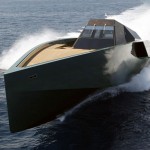
Ever wonder how the interiors of superyachts have the magical ability to make you feel so fabulous the minute you step aboard? Here we got the chance to sit down with interior designer Carla Guilhelm, the creative force behind the stunning interiors of numerous Van der Valk and Bering Yachts, and who recently unveiled “Esthec by Carla Guilhem,” a forward-thinking approach to nautical decking.
Van der Valk Shipyard in the Netherlands, creator of the famous Blue Jean, is set to infuse the unique visions of seasoned owners with 30 years of maritime experience, along with the creative flair of exterior designer Guido de Groot and interior designer Carla Guilhem, with Project 111.11. This 34-meter superyacht builds upon the successful hull design of the award-winning Lady Lene, serving as a canvas for a fully customized superstructure and four decks of unrivaled entertainment amenities.
In addition to revolutionary interior design, Bering Yachts also revealed some major changes and partnerships last month at FLIBS, including a new lineup of long-range explorer catamarans, all crafted from sleek and robust full aluminum, as well as a groundbreaking collaboration with Outsail, trailblazers in autonomous airfoil sails. These cutting-edge wings, born out of modern aerodynamic wizardry, seamlessly fuse the operational ease of a powerboat with the cost-efficiency of a sailboat.
Carla’s work encompasses various design/build projects, including luxury residential, high-end condominiums, commercial, hospitality, and yacht interior design. Her innovative designs have earned her numerous awards and recognitions, such as the ‘Best Yacht Interior’ at the 2023 Boat International Superyacht Design & Innovation Awards.

Q: How did you get into the world of interior design in the boating industry?
A: My passion for design was kindled in my home country of Brazil, where I was involved with my family’s furniture business. This early exposure to the intricacies of materiality and craftsmanship fostered my love for bespoke creations. I sought to broaden this foundation with a formal education in architecture, which further honed my appreciation for spatial design and structural aesthetics. While pursuing growth and expertise in the design realm, I relocated to Europe, where I immersed myself in Italy’s rich design culture before moving to Spain. There, I completed my studies in Interior Design at the Instituto Europeo di Design in Madrid. This experience was pivotal, allowing me to refine my aesthetic sensibilities and design philosophy.
My foray into the yachting world came as a natural extension of the work that we have been developing. It was a serendipitous invitation from a client who asked me to help him design the interiors of his next fully custom superyacht Lady Lene. Embracing this challenge, I brought to life an interior that fully reflected the client’s vision and very particular wishes to create a home at sea for three generations of the family. This debut project was recognized – amongst other awards – with the 2023 BOAT International Superyachts Design and Innovation Award for Best Interior, a milestone that cemented our studio’s reputation in the industry.

Q: What are some of the biggest challenges when designing on a boat (versus in homes/buildings) ?
A: Designing a yacht presents a distinctive set of challenges that differ significantly from static residential or commercial environments. The perpetual motion of a yacht introduces a dynamic aspect to design, where interiors must be crafted to adapt to the changing external environments and moods. This requires a deft hand in creating spaces that can transform into purpose and ambiance, reflecting the time of day, the weather, and the destination, while always providing a constant feeling of comfort and luxury.
Another pivotal challenge is balancing the yacht owner’s vision for the space with the practical necessities of maritime life. A yacht’s interior must not only evoke the desired emotions and sensations for the owner but also must maintain high levels of functionality, such as cleverly integrated storage solutions and efficient use of space. These functional aspects must be seamlessly woven into the design without compromising the aesthetic or experiential quality.
Furthermore, the crew’s needs are just as important. The design must facilitate ease of movement, serviceability, and operational efficiency for the crew, who are integral to the yacht’s day-to-day functioning. We must, therefore, devise creative and intelligent design solutions that cater to both the luxury and comfort of the owner and their guests, as well as the practical working requirements of the crew. Lastly, achieving a design that is both timeless and deeply personal to the owner is a sophisticated balancing act. It involves identifying and incorporating elements that reflect the owner’s unique taste and lifestyle, ensuring the design remains relevant and appealing over time. This often means avoiding overly trendy choices that may quickly become outdated, instead opting for classic luxury that can be accented with personal touches, custom artwork, and bespoke features that express the owner’s individuality.
In essence, the art of yacht design is about crafting a narrative that harmoniously blends movement, emotion, functionality, and personal expression within the unique confines of a vessel that is both a home and a mode of transport across the world’s oceans.

Q: What are some things you notice right away when stepping aboard a yacht? (particularly things us regular people might not notice)
A: When I step aboard a yacht, my designer’s eye immediately gravitates toward the nuanced elements that contribute to the vessel’s overall narrative. There are several subtle details that I notice, which might elude the casual observer. Firstly, the quality of materials is something that stands out to me almost instantly. I assess the type of surface finishes — whether the stone is authentically sourced, the woodwork is properly treated and suitable for the marine environment, and whether textiles are not only luxurious to the touch but also have the performance characteristics necessary for durability at sea. The craftsmanship, particularly the quality of joinery, is a telltale sign of the yacht’s caliber.
The way materials meet — the seams between wood and metal, the integration of glass, and the finish on stonework — these details speak volumes about the level of skill and attention invested into the yacht’s creation. Superior craftsmanship ensures that these encounters are almost imperceptible, with materials appearing as though they naturally flow together. I also notice the sophistication of the little details that might not immediately catch the eye. This could be the custom-designed hardware on cabinets, the intricate stitching on leather furnishings, or the bespoke lighting fixtures that are designed to complement the space perfectly. These elements might be subtle, but they contribute significantly to the yacht’s ambience and bespoke nature.
Lastly, the level of customization and attention to detail can transform a beautiful yacht into a masterpiece. This includes everything from the engraving on a door handle to the personalized art installations that make the space unique to the owner. The placement of each object, the choice of color, the texture of a fabric — they all tell a story about the owner’s tastes and the designer’s dedication to creating a harmonious and personalized onboard experience. Regular visitors might marvel at the beauty and luxury of a yacht’s interior, but it is these finer points — the quality and finish of materials, the exceptional craftsmanship, and the personal touches — that truly set apart an extraordinary yacht interior from the ordinary.

Q: What’s the craziest thing that’s ever happened to you on a boat?
A: In the world of yacht design, where the environment is as dynamic as the seas, every project brings its own set of unique challenges and stories. However, ‘crazy’ incidents are typically kept to a minimum, as meticulous planning and professional execution are hallmarks of our industry. That said, the most unexpected moments often come from nature’s own display when at sea – like the time a design presentation on the deck was serendipitously underscored by a breathtakingly close encounter with a pod of dolphins, which seemed to approve of our color palette for the exterior cushions. Such moments, while not crazy, are certainly awe-inspiring and serve as a reminder of why we strive to create harmonious designs that complement the natural beauty of the sea.
Q: If you could have any yacht in the world, which one would you take and why? (It doesn’t have to be one of your clients!)
A: Very hard to answer this question… About design there are some names that pop-up in my mind as Kensho, Endeavour, Magellano, 111.11. There are too many possibilities to create something special in the design world. I believe, if I could choose one, it will be a creation of something completely new and different of what I already see.
Related



A deep dive into all the different types of yachts, from pocket yachts to superyachts and everything...

